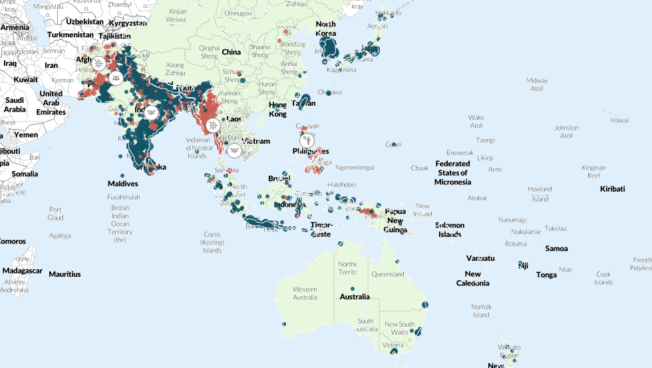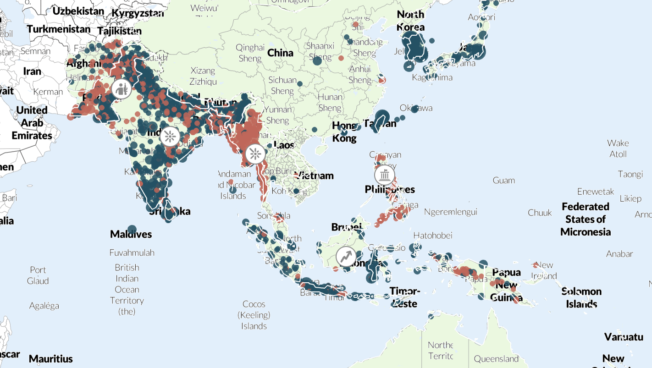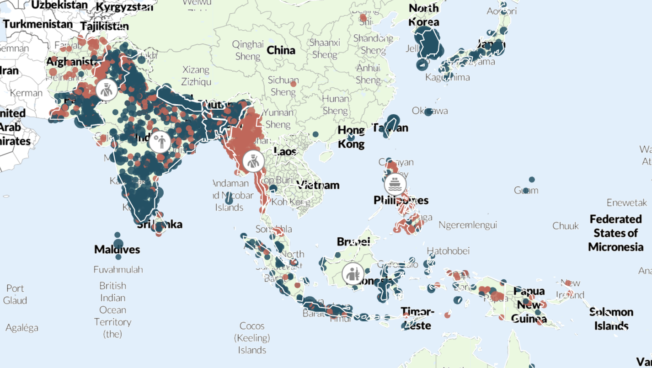Regional Overview
Asia-Pacific
February 2024
Posted: 8 March 2024
 Papua New Guinea: Dozens killed in tribal violence in Enga province
Papua New Guinea: Dozens killed in tribal violence in Enga province
At least 49 people were reportedly killed on 18 February when the Sikin, Kaekin, and Palinu tribes clashed with the Ambulin and Sau Walep tribes in Wabag, Enga province. The violence erupted when the Ambulin tribe ambushed the other tribes in the village of Akom, on the border of Wabag and Wapenamanda districts, reportedly after hearing about a potential planned attack on them. The resulting fighting reportedly involved up to 17 tribes and included hired gunmen. During a press conference following the clash, the Sikin and Kaekin tribes said they were ready to lay down arms and appealed to their rivals to accept a government-mediated peace deal.1Post-Courier, ’Fighting tribes in Enga call for peace,’ 28 February 2024 However, on 29 February, a tribal mob — allegedly armed with guns and bush knives — attacked police as they attempted to bring an Enga businessman in for questioning over his alleged funding of the tribal fight.2Post-Courier, ‘Person of interest reveals role in tribal war,’ 4 March 2024, Print newspaper Resource-rich Enga province is the site of regular outbreaks of violence among multiple tribes and communal groups; ACLED records at least 240 reported fatalities in the past year (for more, see ACLED’s recent Q&A on The Worsening Trend of Violence in Papua New Guinea).
 Indonesia: Outbreaks of electoral violence and demonstrations amid election controversies
Indonesia: Outbreaks of electoral violence and demonstrations amid election controversies
In Indonesia, right-wing nationalist presidential candidate Prabowo Subianto claimed victory after the general election’s preliminary results; the official tally is expected by 20 March. Incumbent Joko Widodo’s son Gibran Rakabuming will serve as Prabowo’s vice president, following a controversial Constitutional Court ruling that allowed him to run despite not meeting the minimum age requirements. Prabowo, who twice lost to Jokowi in past elections, has been long accused of being involved in human rights violations as a military general during the Soeharto dictatorship.3Koh Ewe, ‘What to Know About Prabowo Subianto as Uncertainty Looms for Indonesia’s Democracy,’ Time, 14 February 2024
More than 150 election-related demonstrations were reported during the month, both ahead of and following the vote, including demonstrations disputing election results and accusing outgoing President Widodo of undermining the integrity of the elections. ACLED also records dozens of election-related mob violence events that together reportedly left nearly 100 people injured and three people dead. Violence was at its highest levels in West Nusa Tenggara and Papua, where voting infrastructure was directly targeted. Rioters damaged voting stations in West Nusa Tenggara, while the West Papua National Liberation Army confiscated at least 119 election ballot boxes in Intan Jaya, Central Papua.4Nila, ‘Officials hunts criminal armed group who shot Wings Air aircraft, allegedly seized 119 election ballot boxes,’ Tribunnews, 18 February 2024
 Pakistan: Disputed elections met with increased militancy and election-related disorder
Pakistan: Disputed elections met with increased militancy and election-related disorder
On 8 February, Pakistan held elections for its national and provincial assemblies, amid widespread allegations that the army interfered in the conduct of the elections to disfavor former Prime Minister Imran Khan’s Pakistan Tehreek-e-Insaaf (PTI) party.5Hannah Ellis-Petersen and Shah Meer Baloch, ‘Imran Khan allies claim shock victory in Pakistan election despite crackdown,’ The Guardian, 9 February 2024 While the Pakistan Muslim League-Nawaz (PML-N) was widely considered the favorite, polling day sprang a surprise result. Despite the imprisonment of their leader, Khan, and the loss of their official party symbol, PTI candidates, standing as independents, won the highest number of seats in the national assembly, although they fell short of the majority. Delays in the publication of the results and reversal of announced victors, however, led to allegations of rigging and prompted demonstrations, with the PTI, among other parties, claiming that their mandate had been “stolen.”6Abid Hussain, ‘“Mandate thieves”: New Pakistan government takes shape amid slew of jabs,’ Al Jazeera, 14 February 2024; Kiyya Baloch, ‘Why are Balochistan’s political parties up in arms?,’ Dawn (Pakistan), 29 February 2024
In February, ACLED records over 300 demonstrations rejecting the election results, led not only by the PTI but also by Baloch and Pashtun nationalist parties and Islamist parties. At least four political party supporters were reportedly killed in the ensuing police crackdown. Meanwhile, the PML-N and the Pakistan Peoples Party (PPP), which won the second and third highest number of seats, respectively, joined forces to form a coalition government.7Charlotte Greenfield and Asif Shahzad, ‘Pakistan’s Shehbaz Sharif takes oath as prime minister, directs team to talk with IMF,’ Reuters, 5 March 2024 On 4 March, Shehbaz Sharif from the PML-N was sworn in as prime minister for a second term.8Charlotte Greenfield and Asif Shahzad, ‘Pakistan’s Shehbaz Sharif takes oath as prime minister, directs team to talk with IMF,’ Reuters, 5 March 2024 Meanwhile, escalating militant attacks in the run-up to and during the elections also disrupted the polling process, driving an over 50% increase in political violence in February compared to the month prior.
For more, see ACLED’s report on militant violence and the repression of the opposition ahead of Pakistan’s elections.
 India: Farmers renew protests for economic protections
India: Farmers renew protests for economic protections
Two years after ending a months-long protest against planned agricultural reforms, thousands of farmers once again took to the streets in February, demanding legal guarantees for minimum crop prices and fulfillment of unkept promises from their first protest movement.9BBC, ‘Why India farmers are protesting again,’ 13 February 2024 The latest wave of protests is led by the Kisan Mazdoor Morcha and the Samyukt Kisan Morcha (Non-Political), umbrella bodies of over 100 farm unions.10Raakhi Jagga, ‘Meet key faces of farm protest 2.0: A rebel and a lone warrior,’ Indian Express, 14 February 2024 ACLED records more than 650 demonstrations over farmer-related issues in February. While the demonstrations have been concentrated in north India, the farmers’ call for a national shutdown on 16 February received support in 22 of India’s 36 states and union territories. Police forces violently cracked down on the demonstrations, using tear gas-filled drones and pellet guns to disperse demonstrators, leading to hundreds of reported injuries and at least one fatality. Human rights groups called on the government to protect the farmers’ right to peaceful protest.11Human Rights Watch, ‘India: Protect Farmers’ Right to Peaceful Protest,’ 29 February 2024 Meanwhile, farmers renewed calls for a protest march to Delhi in March, even as farmers from Punjab and Haryana remain camped at the Shambhu and Khanauri inter-state border crossings due to barricades along the national highways leading to the capital.12The Hindu, ‘Farmers give call for “Delhi Chalo” on March 6, “rail roko” on March 10,’ 3 March 2024; Puja Das, ‘Farmers’ leaders to meet union ministers after police use pellet guns, tear gas on protesters,’ Live Mint, 14 February 2024 With opposition parties extending support to the movement, farmer protests pose a challenge for Prime Minister Narendra Modi ahead of the upcoming general elections scheduled for April and May.13The Economist, ‘Massive farmers’ protests are a headache for Narendra Modi,’ 29 February 2024
 Myanmar: Fighting between the army and resistance forces rages in upper Myanmar and Rakhine state
Myanmar: Fighting between the army and resistance forces rages in upper Myanmar and Rakhine state
Sagaing region was home to fresh fighting as the Myanmar military tried to regain control of Kawlin town, which was captured by resistance forces in November. Kawlin, situated near the border of Kachin state and Sagaing region, was the first district-level town to fall to the National Unity Government (NUG). The town is not just a significant position for transporting supplies to major battlefronts14Myitkyina Journal, ‘Kawlin Town’s Key Strategic Points Recaptured by Junta,’ 14 February 2024 but also symbolically and politically important for the military.15BBC News, ‘PDF and PaKaPha Continue to Control Kawlin,’ 12 February 2024 While frequent attacks targeting Kawlin have persisted for the past three months, starting from 3 February the military increased efforts from two directions, Wuntho township from the north and Kanbalu township from the south,16Radio Free Asia, ‘The Military Escalates Efforts to Recapture Kawlin,’ 6 February 2024 deploying about 800 troops17Nora Pyae, ‘Hundreds of junta troops attempt to retake Kawlin town from resistance’, Myanmar Now, 7 February 2024. and launching airstrikes, drone strikes, and artillery fire. Resistance forces eventually lost Kawlin to the military in mid-February.18Radio Free Asia, ‘The Military Escalates Efforts to Recapture Kawlin,’ 6 February 2024 The offensive drove a 64% increase in political violence in Sagaing region in February compared to the month prior.
Meanwhile, fighting also escalated throughout Rakhine state, with the military losing more territory to the United League of Arakan/Arakan Army (ULA/AA). The ULA/AA, which has said it aims to control the whole state, continued to attack military bases and border guard outposts — from northwest towns on the border with Bangladesh to those in the south.19BBC Bews, ‘Exclusive interview with AA Chief Tun Marat Naing part II’, 3 February 2024. Amid the offensive, the ULA/AA sank three military vessels in Kyauktaw township on 8 February, inflicting several military fatalities and signaling its increased ability to strike naval vessels. Between 6 and 12 February, the ULA/AA captured Kyauktaw, Mrauk-U, and Myebon towns, then gave an ultimatum to the Military Regional Operation Command based in Sittwe, the capital town of Rakhine state, demanding it surrender by the end of the month.20Western News, ‘AA warns Sittwe-based Military Operation Command to surrender,’ 15 February 2024 The military instead responded with mass arrests and shelling that reportedly killed 12 civilians in Sittwe market. The ongoing fighting between the ULA/AA and the military has raised concerns about its potential to undermine wider regional stability. Notably, during a clash with the ULA/AA in Maungdaw township, cross-border shelling reportedly killed at least two civilians in Bangladeshi territory. Subsequently, over 100 border guard police crossed the border to Bangladesh to flee the fighting.21Muktadir Rashid, ‘Bangladesh grills Myanmar Junta over cross-border shelling,’ The Irrawaddy, 6 February 2024
 Philippines: Clashes between the government and NPA rebels surge
Philippines: Clashes between the government and NPA rebels surge
In the Philippines’ Western Visayas region, communist New People’s Army (NPA) rebels and government soldiers engaged in heavy clashes during the latter half of February. Fighting in Escalante City, Negros Occidental reportedly led to the deaths of at least three NPA militants and the wounding of at least four state forces personnel on 21 February. A second day of fighting in the area also saw a government airstrike on an NPA position that a local human rights group subsequently condemned as “indiscriminate.”22Reymon Titung, ‘Military launches airstrike after fierce clashes in Negros Occidental,’ Rappler, 23 February 2024 Meanwhile, a clash in Bilar town, Bohol, Central Visayas, on 23 February also reportedly caused multiple fatalities, including five NPA militants and a police officer.23Kit Bagaipo, ‘NPA commander, 4 other suspected rebels killed in Bilar clash,’ Bohol Chronicle, 23 February 2024 The surge in fighting continued into the last week of February, when at least 10 more clashes erupted, including in Western Visayas. The fighting in Western Visayas underscores the persistence of the insurgency in the largely rural region, where long-standing social problems have provided fertile ground for rebellion (for more on the conflict in Western Visayas, see this ACLED report on the communist insurgency in the Philippines). Elsewhere, on 27 February, the army killed a rebel leader serving as the secretary of the Western Mindanao Regional Party Committee of the Communist Party of the Philippines (CPP) during a clash in Dumingag, Zamboanga del Sur, Zamboanga Peninsula.
See More
See the Codebook and the User Guide for an overview of ACLED’s core methodology. For additional documentation, check the Resource Library. Region-specific methodology briefs can be accessed below.
Links:
- Methodology and Coding Decisions for Political Violence and Demonstrations in Afghanistan
- Methodology and Coding Decisions for Political Violence and Demonstrations in China
- Methodology and Coding Decisions for Political Violence and Demonstrations in Myanmar
- Methodology and Coding Decisions for Political Violence and Demonstrations in North Korea
- Methodology and Coding Decisions for the Philippines Drug War







